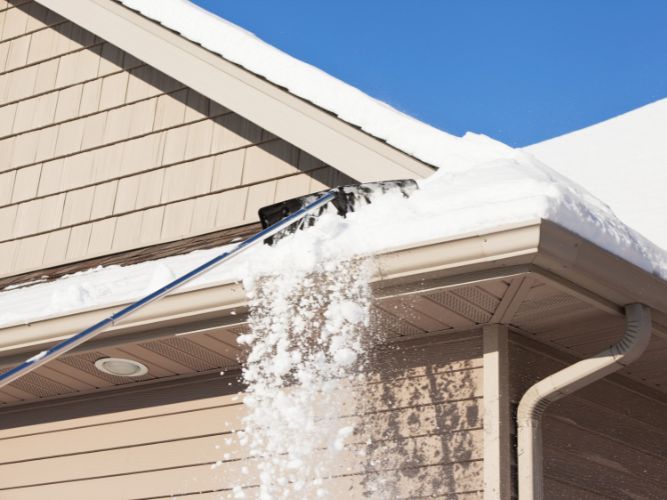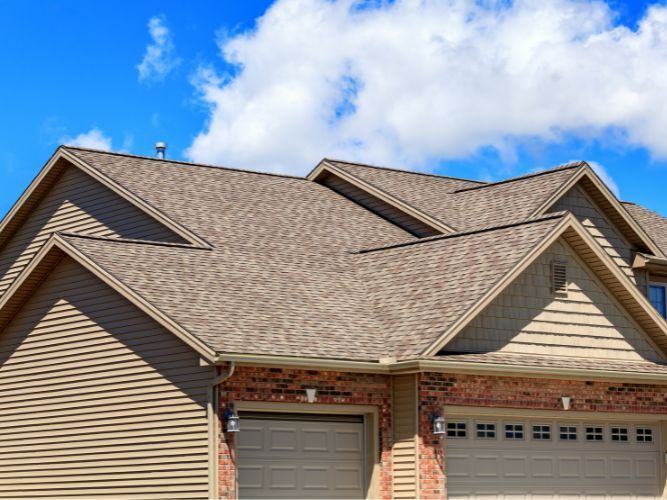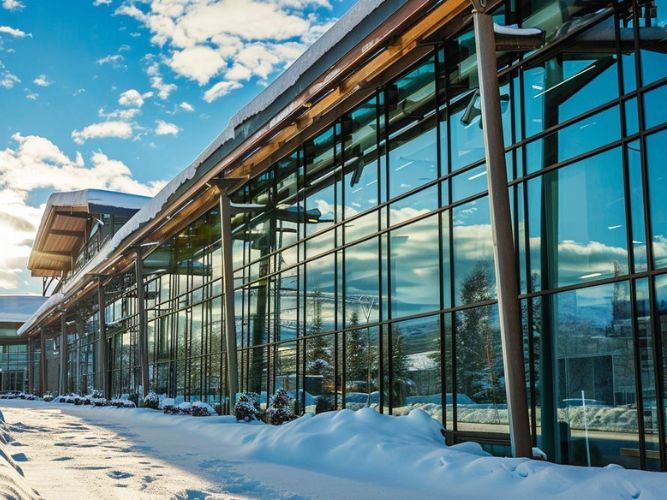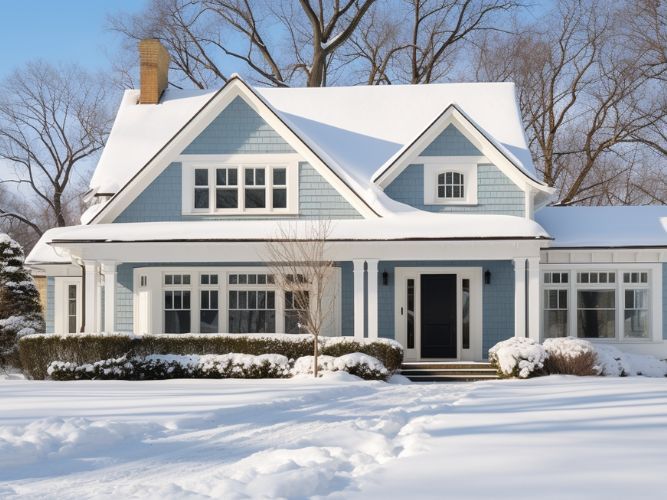Preparing Your Roof for Winter: Essential Fall Checks and Repairs
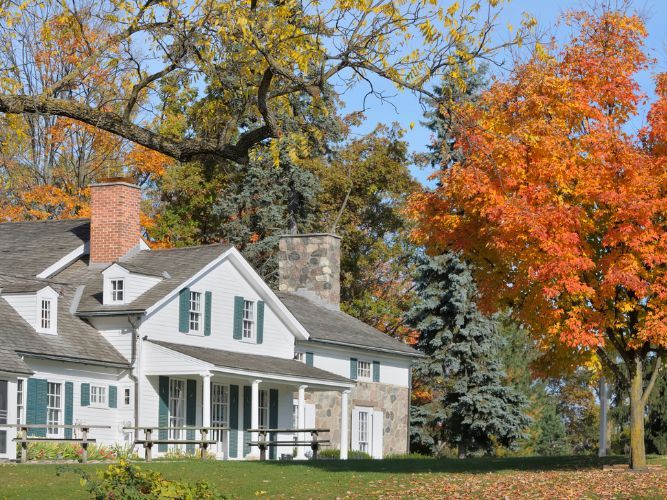
The winter season can be harsh on your roof, and it is important to understand the potential effect it can have. Taking proactive steps such as creating a checklist for key areas to inspect, understanding the importance of gutter cleaning in the fall, as well as identifying and repairing potential problem areas, can help ensure your roof can withstand the harsh winter weather.
Understanding the Effects of Winter on Your Roof
Winter weather can wreak havoc on a roof, causing costly and inconvenient damage to shingles, seals, and the entire roof structure. It is, therefore, important for homeowners to understand what winter weather can do to a roof and how to prepare for it before the cold weather sets in.
One of the primary risks posed by winter weather to a roof is extreme temperatures and snow or ice buildup. Shingles, which are the primary protective layer of your roof, are most vulnerable to temperature swings and contraction and expansion from heat to cold. If the shingles contract, the seals between them may be compromised, allowing water to get under the shingles and possibly damaging the roofing materials underneath. Similarly, large, heavy buildups of snow or ice can be extremely damaging to a roof, potentially resulting in roof collapse. It is, therefore, essential to remove all snow and ice accumulation periodically throughout the winter months to avoid structural damage to your roof.
On the other hand, the lack of sunlight over the winter months can lead to the growth of moss or algae on the roof. Not only can this be aesthetically displeasing but it can also be damaging to the integrity of your shingles by softening them and making them more vulnerable to water penetration. Moreover, patches of moss can provide a method for moisture to enter the roof despite the presence of a shingles-layer. To combat this, homeowners can treat their roofs with a moss-inhibitor, typically available in stores, to prevent moss growth.
In addition, winter weather can sometimes cause wind damage to a roof, particularly to shingles and seals. Inspecting your roof for any obvious damage, such as loose shingles or lifted seals, during or after Hall storms will help homeowners reduce the damage their roofs are exposed to from wind. Furthermore, ensuring that tree branches or other debris flying in the wind are trimmed back from the roof and can also help to protect it.
Although it may sound daunting, protecting a roof from the damage exposed to it from winter weather doesn’t have to be difficult. Simple steps such as periodically removing snow, treating the roof for moss, and cleaning around the roof can go a long way in helping to ensure your roof is able to withstand winter weather. As a result, it is important to understand the risks winter weather can impose on a roof and adequately preparing for it before the cold weather sets in.
The Checklist: Key Areas to Inspect On Your Roof Before Snowfall
Checking the condition of a roof prior to snowfall is essential for preventing property damage or further deteriorating an existing roof structure. As a result, the amount of time, effort and money spent on pre-snow roof preparation should not be underestimated. Nevertheless, it is important to identify the key areas to inspect in order to ensure a thorough roof inspection. Moreover, the checklist below has been designed to assist in the process and covers all major inspection areas.
Firstly, roofing materials and structure are integral components in determining the condition of the roof. Generally, it is necessary to check for any missing, loose or damaged shingles, tiles or structures. Similarly, flashing should be inspected around vents, chimneys and walls to prevent potential leaking. In addition, inspecting the quality of existing gutters and downspouts is essential in ensuring effective disposing of rainfall. Furthermore, checking for the presence of mold, moss or algae can indicate moisture problems that affect the structural integrity of the roof.
It is also important to inspect penetrations on the roof, such as skylights, fans and antennas. In contrast, examining all attic vents, and making adjustments to them if necessary, is a key in making sure heat and moisture is correctly ventilated out of the attic. Moreover, making sure the siding is clean and clear of debris protects against the accumulation of moisture. Finally, it is important to look for any signs of pest or animal control on a roof.
Therefore, in order to ensure a well-maintained roof before snowfall, it is important to conduct a full inspection in all the areas outlined above. By doing so, it is possible to identify existing problems and take action to prevent further deterioration. Furthermore, it is also important to keep in mind that seasonal roof maintenance should always be done by a qualified professional.
Importance of Gutter Cleaning in Fall
Gutter cleaning in the fall is essential for protecting homes from water damage. By removing dirt, leaves and other debris, gutters are able to effectively funnel rainwater away from the roof. This can help to protect the foundation and walls of the home from water damage as well as stop the growth of damaging mold and mildew. Moreover, cleaning gutters can also stop pests like rodents and birds from making nests in the gutters.
In addition, with the development of gutter guards and leaf guards, gutter cleaning in the fall is now even more important. These gutter guards prevent debris from entering the gutters, reducing the amount of overall maintenance needed. However, this debris can still lead to buildup and can clog even the most advanced gutter guard systems. Therefore, it is still important to have a yearly gutter inspection and cleaning in the fall to make sure that the gutters are running properly and are clog-free.
One common sign that gutters are clogged is overflowing water or pooled water near the foundation or near the entrance of the gutter. This can indicate the need for a gutter cleanup. Similarly, if leaves and granules from the roof are found around the home, this can be a result of improper gutter maintenance and require a gutter cleaning.
Consequently, without regular gutter cleaning, homeowners can be left with serious water damage issues, including flooding and mould growth. To avoid these issues, regular gutter maintenance is essential in the fall, as well as throughout the year.
Identifying and Repairing Potential Roof Problem Areas
Identifying potential roof problems can be a difficult and challenging task. However, there are a few areas that can be inspected which can help identify common roof issues. The first of these is the amount of wear and tear on the roof. Wear and tear can indicate a need to repair or replace the roof. In addition, it is important to inspect the flashing on the roof. This is the metal material that is typically placed in the valleys and around chimneys and other protrusions from the roof, and it is essential for watertight seals. Flashing should be in good condition, or it may need to be replaced if it has degraded over time. Furthermore, it is important to check the gutters and downspouts for leaks or blockages. If the gutters are clogged with leaves or debris, they may not be able to properly channel water away from the roof and the foundation of the home.
Once roofing issues have been identified, it is time to begin the repair process. Repairing each issue can involve different processes depending on the material of the roof, and the severity of the damage. In contrast, all repairs require the removal of any debris and the repair or replacement of any faulty components. Similarly, sealants and primers may need to be applied, followed by the application of a waterproof coating. Finally, nails and spacers may need to be added to complete the repair. As a result of the repair process, homeowners can have peace of mind that the roof is safe and secure to protect their home from the elements. Consequently, identifying and repairing potential roof problems is key for any homeowner.
Key Takeaways
Overall, taking the necessary precautions in the fall to understand how the winter will affect your roof can help prolong its life expectancy. With the help of a qualified roofing professional, you can make sure that your roof is in good condition before the snow arrives. It is also important to have your gutters cleaned in the fall in order to keep water and debris out of your home, while identifying and repairing potential roof problems areas can also aid in roof maintenance. Following this checklist of key areas to inspect on your roof before snowfall, as well as the advice of a professional roofer, is a cost-effective way to maintain the condition of your roof and ensure that you and your family remain safe and warm throughout the winter.
Frequently Asked Questions
How can ice dams affect my roof?
Ice dams are a common problem in winter months where snow and ice accumulate on rooftops. They can cause a lot of damage to roofs and the structures beneath them. The melting snow and ice can seep into the roof deck and get into the attic, saturating insulation and potentially causing damage to ceilings and walls. The water can also start to back up under the shingles and eventually cause water damage and leaks. In severe cases, ice dams can also cause the roof structure to become weakened and collapse.
What’s the difference between re-roofing and roof repair?
Re-roofing is the process of completely replacing a roof, while roof repair usually refers to addressing specific issues with the existing roof, such as patching a leak or replacing a few shingles. Re-roofing is typically done when the existing roof is beyond repair or is nearing the end of its service life and needs to be completely replaced.
How can I prevent ice buildup on my roof?
To prevent ice buildup on your roof, you can install heat cables or strips along your roof’s gutters and downspouts. You can also install a snow and ice shield under your roof’s shingles. Additionally, you should ensure your attic and roof are properly insulated and ventilated to prevent warm air from escaping through the roof and melting the snow which can then refreeze. Finally, you can keep gutters clean so that melting snow can flow freely.
Should I remove snow from my roof during winter?
It is generally recommended to remove snow from your roof during winter. Heavy snow can put extra strain on your roof, leading to damaged shingles, rot, and even collapse. Removing the snow may help prevent potential structural problems and help keep your home warm and dry. Make sure to use proper safety precautions when removing snow from above, and if you don’t feel comfortable with the process, consider hiring a professional for the job.


